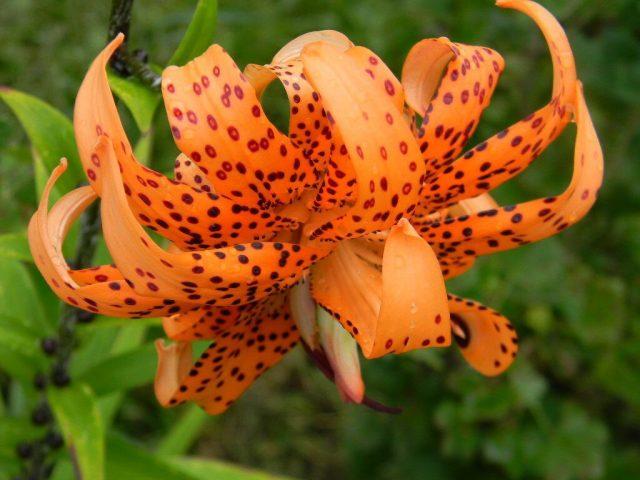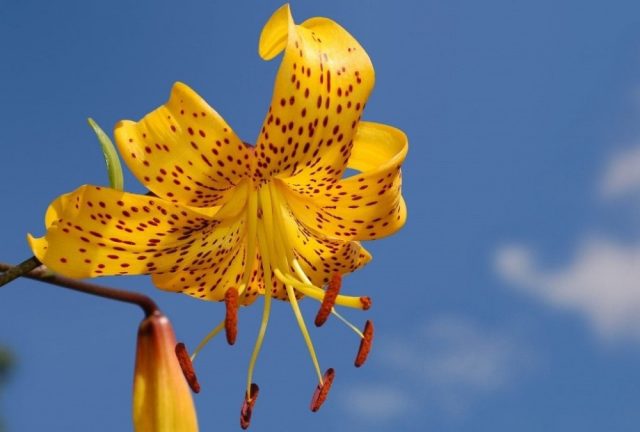Content
Tiger lilies (Lilium Lancifolium) are perhaps the most unpretentious variety of this ornamental plant, which is quite often found in flower beds, parks and gardens. The culture has a beautiful appearance, is distinguished by long-lasting flowering, has high immunity, and is not afraid even of the harsh Siberian winters. The species was bred by specialists from East Asia and quickly won the love of Russian flower growers.

Tiger lilies are easy to grow in your garden; they reproduce easily and take root well
What does a tiger lily look like?
Tiger lily is a bulbous perennial that first appeared in China and Japan. Flower growers began growing this variety of plant in the 19th century.
Judging by the description, in favorable conditions the tiger lily can grow to a height of two meters. Its stems are hard, pubescent, and purple in color.The leaf blades are well developed, can be up to 15 cm long, about 1 cm wide, they are lanceolate in shape, narrow, sessile, dark green in color. Their location on the stem is alternate. The two upper leaves are short; during the warm season, small bulbs are formed in their axils, which are later used for propagating the crop. The root system of the tiger lily is well developed, the heads are large, their shape is spherical, and their color is white.
Lily buds are large in size and resemble bells in appearance. The number of flowers on one plant can reach 10-20 pieces. Inflorescences are racemose, loose. One bud grows up to 12 cm in length, its pedicels are long and pubescent, the color depends on the crop variety, the aroma is weakly expressed. The fruits are a capsule with a large number of flat seeds.
The tiger lily blooms from July to the end of summer. It blooms for the first time three years after planting.
Tiger lily varieties with photos and names
In accordance with the classification of tiger lily, its hybrids belong to the first group (Asian). Depending on the direction of the buds, it has different markings: la, lb, lc. Quite a lot of varieties have been bred. Their difference, in particular, is expressed in the color scheme.
Lady Alice
Lady Alice is a rare hybrid tiger variety with buds whose petals are white with an apricot center and orange streaks. Its flowering occurs a little later than other varieties, closer to August. The height of the bushes is average, about one and a half meters.

Lady Alice is not afraid of cold weather and winters well in the northern regions
Knight Flyer
Night Flyer is a tiger lily, the buds of which are large (16 cm), their color is burgundy-red with a small number of spots, the petals are slightly bent. The hybrid grows well in cold conditions. It reproduces well.

Knight Flyer height is about 1.2 meters
Pink Tiger
Pink Tiger is a variety with large buds of pink or red-orange hue. Petals interspersed with crimson color. The disadvantage of this variety is its susceptibility to infections.

Pink Tiger height is about 120 cm
Fluffy Leopard
Fluffy Leopard (Tigrinum) is a double variety with deep orange flowers with dark spots. Each bud has three dozen petals. The variety loves the sun, so it grows and develops poorly in the shade.

One peduncle of Fluffy Leopard can hold up to 20 buds
Splendes
The tiger lily variety Splendens displays large buds of bright orange color with small black spots. Up to two dozen inflorescences can be concentrated on one stem. The species is hardy and can grow in both open and shaded flowerbeds.

Lily Splendes grows up to 100 cm in height
White Tiger
White Tiger is a variety of tiger lily with large snow-white buds, the petals of which are covered with burgundy dots. The culture is unpretentious, blooms closer to mid-summer.

A characteristic feature of White Tiger is drooping flowers.
Flora of Plena
Flora Pleno is a common variety with orange, heavily double buds decorated with black dots. The species is completely unpretentious and can grow with virtually no care. Flowering is long lasting, about two months.

The height of the stems of Flora Plena rarely exceeds 100 cm
Citronella
Citronella is a short tiger lily with bright yellow buds and brown spots. As the petals bloom, they curl, exposing the long stamens, which is why the culture is called turban-shaped.

The budding period of Citronella lasts no more than a month
Features of growing tiger lily
Despite the fact that the tiger lily flower is unpretentious, its beautiful flowering can only be observed if the conditions of cultivation and care are observed. It is advisable to locate the crop in sunny areas or in partial shade, since it needs sunlight for full development. Bulbs should be planted in suitable soil. The soil should be permeable, light, fertile, with neutral or low acidity. It is advisable to select a site on a hill.
It is important to choose the right time for planting. In the southern regions, tiger lily can be planted both in spring and autumn, but in the northern regions it is better to perform the procedure at the beginning of the season. Before starting work, the soil should be loosened, the planting hole should be well fertilized with potassium salt, humus, superphosphates or a complex of minerals for bulbous plants. In addition, it is advisable to lay a drainage layer at the bottom of the hole.
The tiger lily is planted to a depth of about 20 cm. The distance between plants is maintained at approximately 15 cm.
As for care, it is carried out according to standard rules:
- Watering. Should be moderate but regular. The main thing is to avoid stagnation of liquid. After the crop has faded, there is no need to moisten it at all.
- Feeding.Conducted no more than three times a year. In the spring, nitrogen is used for this purpose, during budding and at the end - potassium-phosphorus compounds.
- Preparing for winter. At the end of summer or early autumn, when the leaves of the tiger lily are dry, its stems are cut to a height of 10 cm above the ground. In the northern regions, before frosts, cover with leaf litter or peat and special material.

For the first couple of years after planting, the tiger lily is mulched and sprinkled with snow for the winter.
Reproduction
Tiger lily can be propagated in several ways:
- Seeds. This method is the easiest. It allows you to obtain a large number of plants at one time, but has a significant drawback - low (70%) germination of the material.
- Bulbs. The method is the most common. It involves planting prepared heads in spring or late summer - early autumn.
- Bud bulbs. Usually this process occurs without the participation of a gardener, by self-sowing. Subsequently, the young shoots are transplanted to a new location. Also in the fall, planting material can be collected and sown in a container, and in the spring planted in a flower bed.
- Scales. This method is used when transplanting lilies. To do this, the scales are separated from the large heads and planted in the ground under a film, put away in a cool place for the winter, and placed in a garden bed in the spring.
Diseases and pests
Tiger lily is not particularly susceptible to disease and pest attacks and is considered a crop that is quite resistant to many ailments. But it is known that it is the main carrier of a disease such as mosaic.
If a crop is planted in alkaline soil, it becomes susceptible to chlorosis. Therefore, in such conditions it should be periodically fed with peat and mulched with sawdust. Tiger lilies can also become infected with gray rot, so it is recommended to treat the bulbs with Fundazol before planting.
Of the insects that can attack perennials, the most common are aphids, chafer larvae and leaf beetles. Plant bulbs can be destroyed by rodents.
Application in landscape design
Tiger lily can often be seen in summer cottages; many of its varieties are widespread in Russian regions. Due to their high height, flowers are usually placed in the central part of the flowerbed and framed by other ornamental crops. Sometimes they play the role of a hedge and can be planted along paths. Tall lilies look good near a fence or in the background of a mixborder. The culture can be used in single plantings, or create a flower bed from varieties of different colors. Marigolds, petunias, salvias, and pelargoniums are perfect neighbors for the plant. Phlox, fern, and juniper look beautiful nearby.

Tiger lilies are often used as cut flowers to create bright bouquets.
Conclusion
Tiger lilies give the garden a special elegance and zest. They have been pleasing flower growers for quite some time with their beautiful and abundant flowering. In addition, the plant is perennial, undemanding to care, and frost-resistant. Even a beginner can cope with its cultivation.








